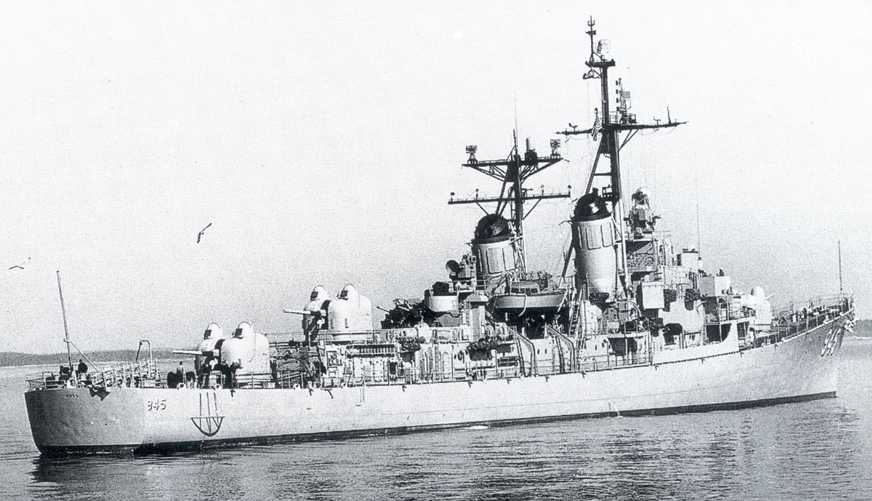| Notes:
1) The Mark 42 Gun Mount was produced in
10 different Mods. Mods 1 through 6 were the first mounts to enter
service and were used on USS Northampton (CLC-1) and DL-2 through DL-5.
The Forest Sherman (DD-931) class were originally equipped with Mods 7
and 8. The Mod 8 mount had a radar system integrated into the mount
which was never really successful. The radars were removed at the
first overhaul and the mounts reverted to a Mod 7 designation. The
Mod 9 mounts were first introduced on the Knox (FF-1052) class frigates
and were a lighter design using all solid-state electronics. Mod
9 was also exported to Spain. Only two men were needed in the gunhouse
in this Mod versus four for the Mod 7. The Mod 7 had superior acceleration
over the Mod 9, 60 degrees per second2 for the Mod 7 versus
40 degrees per second2 for the Mod 9. The Mod 10 mounts
were an upgrade of the Mod 7 mount that entered service in 1970's.
2) This mount is fed by two loader drums
which each hold twenty rounds of ammunition.
3) Later mods were lighter and had lower
manning requirements, falling from 20 men in the original Mod 0 to 13 in
the Mod 9 and to 12 in the Mod 10 (gun captain and 11 crewmen).
4) This mounting operates from 440 Vac
60 Hz three phase.
5) This mounting consists of two component
groups: The lower structure (below deck) and the upper structure
(above deck). Lower structure components include parallel two-stage
hoist/loader drum arrangements that deliver an uninterrupted flow of ammunition
to the gun. Upper structure components load the ammunition, aim the
gun, fire the ammunition and eject the empty powder cases. The lower
structure was originally produced by the US Navy Naval Ordnance Station
in Louisville, Kentucky. The two ammunition loading systems in the
lower component group feed the gun alternatively. Each system has
a cartridge drum and a projectile drum, with each drum holding twenty units
of ammunition. The drums usually rotate together, but the shell drum
can rotate independently of the cartridge drum, which allows different
ammunition to be selected during the loading cycle. The projectile
and cartridge are mated when they leave their respective drums and the
complete round moves from the lower to the upper hoist and then to the
upper hoist and finally to the a cradle which swung up to throw it into
a transfer tray from which it is rammed into the breech. The only
manual element of this system is the placing of the cartridges and projectiles
into the loading drums.
6) Forrest Sherman class destroyers modified
into missile ships lost both of their aft 5"/54 (12.7 cm) guns. Other
members lost No. 2 gun and their 3"/50
(7.62 cm) guns in order to fit an ASROC launcher.
Northampton lost three of her 5"/54 (12.7 cm) guns by the time she was
decommissioned in January 1970. Forrestal class carriers lost their
four forward 5"/54 (12.7 cm) guns in the early 1960s as it was found that
their sponsons slowed the ship down in rough seas. The after guns
followed in the 1970s, with Ranger CVA-61 being the last active carrier
to carry 5"/54 (12.7 cm) guns until her last pair was removed in 1977. |
